Scale up your practice for the Abstract Reasoning Test with our updated Abstract Reasoning Assessment Practice Pack, which covers all the sections of the actual exam. This book provides valuable insights into what to expect and, will be of great help in helping you develop effective study strategies with detailed explanations of every question and hints on how to solve them faster.
About the Abstract Reasoning Test
Abstract reasoning tests measure a candidate’s ability to identify connections among sequences of shapes and patterns. These tests offer insights into your strategic and lateral thinking, to find the accuracy and speed with which you can identify and interpret the relationship between a collection of shapes and patterns. Abstract reasoning tests are non-verbal tests so these tests will not require you to analyse.
An abstract reasoning test is an assessment that employs the use of shapes and patterns to assess your problem-solving skills and ability to spot logical series. For example, you might need to select which image completes a sequence, is missing from the overall picture, or doesn’t correlate to the other images shown.
What to Expect From the Abstract Reasoning Assessment
Format
- Typically, a multiple-choice test with 30-50 questions
-
Questions are presented in a series of diagrams, patterns, or shapes
-
You’ll have a limited time to complete the test (usually 30-60 minutes)
Question Types
-
Pattern recognition: Identify the next shape or pattern in a sequence
-
Analogies: Determine the relationship between shapes or concepts
-
Logical deductions: Draw conclusions based on the given information
-
Shape transformations: Identify how shapes change or rotate
How to Prepare for the Abstract Reasoning Assessment
Practice Tests
-
Take sample tests to familiarize yourself with the format and question types
- Practice under timed conditions to simulate the actual test experience
Remember, preparation is key! The more you practice, the more confident and prepared you’ll be for the assessment.
Sample Abstract Reasoning Practice Questions
Question 1
Which shape comes next in the sequence?
- A
- B
- C
- D
- E
The Correct Answer; E
Explanation:
The black and white dots are alternating between 5 and 7 in number. The last picture contains 5 white dots and 7 black ones, meaning the following image should contain 7 white dots and 5 black ones.
Question 2
Complete the sequence;
- A
- B
- C
- D
- E
The Correct Answer: B
Explanation:
Each tile contains 2 overlapping shapes, 1 larger than the other. As the 2 shapes overlap a new one, a smaller shape is created inside the first large shape. The large shape in the following tile corresponds directly with the new shape created. When the shapes overlap the largest bisection is always within the biggest shape.
Question 3
Complete the sequence;
- A
- B
- C
- D
- E
The Correct Answer; C
Explanation:
The first two rules are relatively easy to work out. The shape in the center alternates between orange and white and the navy dot moves around the tile corners in a clockwise direction.
The real challenge is spotting that the big black square is moving around the sides and corners of the tile in alternating directions, first anti-clockwise, then clockwise.
It also increases how many spaces it moves in increments of one. First, it moves anti-clockwise in one position, then moves 2 spaces clockwise then, 3 anti-clockwise, and so on.
Question 4
Which is the odd string of letters out;
- A
- B
- C
- D
- E
The Correct Answer; E
Explanation:
Each string of letters contains S, F, G, H, and J appearing in a loop. It is easier to imagine if you can see multiple loops appearing consecutively: S-F-G-H-J-S-F-G-H-J-S-F-G-H-J A, B, C, and D strings all include letters in the right order to fit in the same loop. For example, F always follows S and precedes G however in the last string (E) The letters are out of order.
Question 5
Complete the sequence;
- A
- B
- C
- D
- E
The Correct Answer; B
Explanation:
There are 4 rules consistent in this sequence. First, the number of dots that appear in the center decreases by one, as is the number of sides that appear on the black shape. The triangle is being flipped sideways and then back again and finally, the square in the corner remains the same.
Question 6
Which figure is the odd one out?
- A
- B
- C
- D
- E
The Correct Answer is B
Explanation:
Figure B is the odd one out. It is the only one in which the diagonals in the
diagonal-within-square are not the same.
Question 7
Which figure is the odd one out?
- A
- B
- C
- D
- E
The Correct Answer is C
Explanation:
Figure C is the odd one out. It is the only figure which does not contain one of
each of the sets of shapes, the second and fifth are identical.
Question 8
- A
- B
- C
- D
- E
The Correct Answer is B
Explanation:
Diagonally opposite corners of the grid are color inversions. Option B completes the grid.
Question 9
- A
- B
- C
- D
- E
The Correct Answer is C
Explanation:
The halves of the grid are mirror images in the vertical plane. Option C completes the grid.
Question 10
Which figure is next in the series?
- A
- B
- C
- D
The Correct Answer is A
Explanation:
The top halves of the dominoes have the ascending sequence Blank, 1, 2, 3, etc.
The bottom halves have to repeat the sequence 3, Blank, 3, Blank, etc. Alternate
dominoes are then inverted. Option A completes this sequence


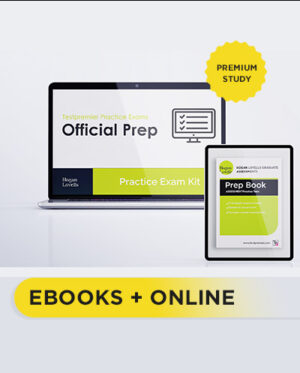






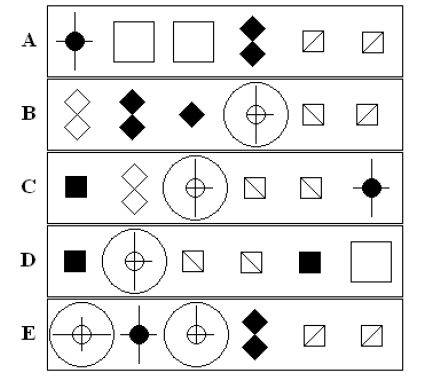
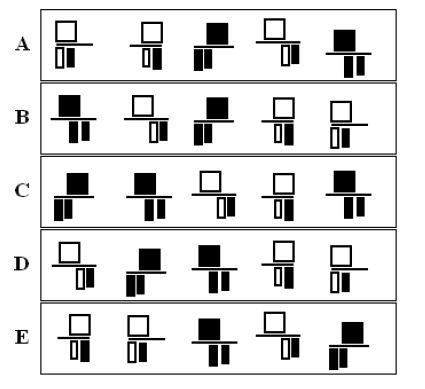
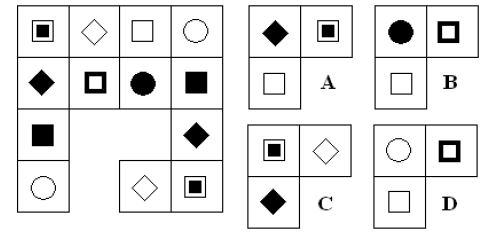
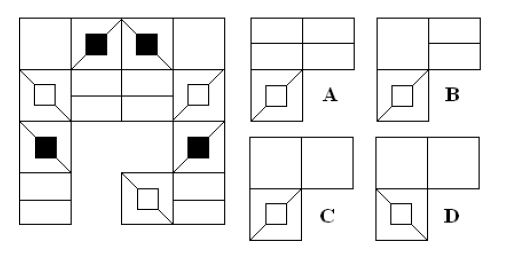
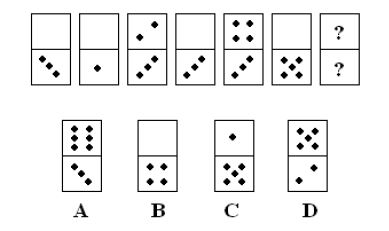

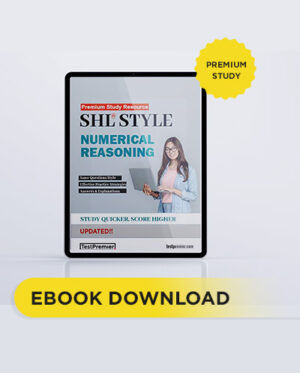

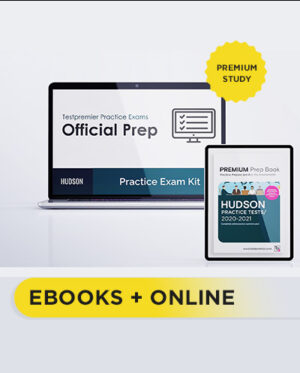
Reviews
There are no reviews yet.